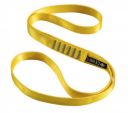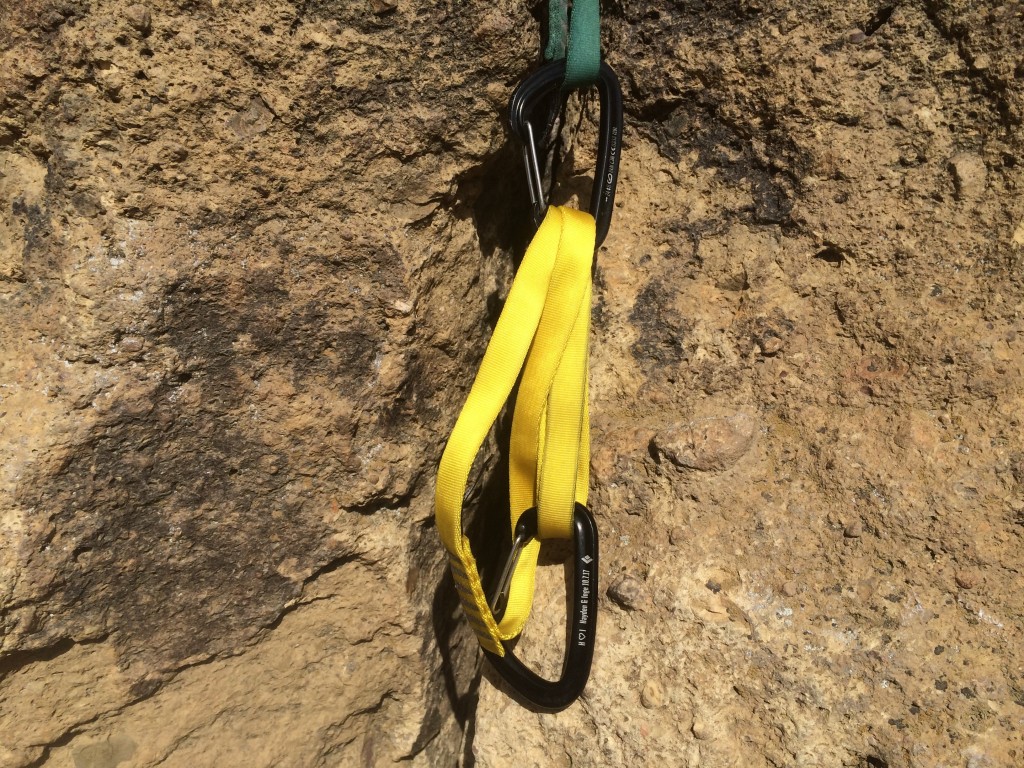Black Diamond Nylon Sewn Runner Review
Our Verdict
Compare to Similar Products
 This Product
Black Diamond Nylon Sewn Runner | |||||
|---|---|---|---|---|---|
| Awards | Best Bang for the Buck | Best Overall Climbing Sling | |||
| Price | $6.95 at REI Compare at 3 sellers | $10.00 List $9.95 at REI | $8.95 at REI Compare at 2 sellers | $10.95 at REI Compare at 3 sellers | $9.99 at Backcountry Compare at 2 sellers |
Overall Score  |
|||||
| Star Rating | |||||
| Bottom Line | A small trade-off in performance for a relatively large savings in cost when considering buying a whole rack | Our Editors’ Choice winner because it is lighter and more compact than any other without compromising performance | One of the highest value options that we tested | One of the best value purchases available for a climbing sling | Performs exactly the same as the Black Diamond Nylon Sewn Runner except it costs more |
| Rating Categories | Black Diamond Nylon... | Mammut Contact Dyneema | Black Diamond Dynex... | Trango Low Bulk 11m... | Sterling Nylon Sewn... |
| Handle (25%) | |||||
| Knot Test (25%) | |||||
| Alpine Quickdraw Test (20%) | |||||
| Weight (15%) | |||||
| Bulk (15%) | |||||
| Specs | Black Diamond Nylon... | Mammut Contact Dyneema | Black Diamond Dynex... | Trango Low Bulk 11m... | Sterling Nylon Sewn... |
| Type of Fiber | Nylon | Dyneema | Dynex | Dyneema | Nylon |
| Measured weight | 37g | 19g | 20g | 20g | 38g |
| Width Tested | 18mm | 8mm | 10mm | 11mm | 17mm |
| Length Tested | 60cm | 60cm | 60cm | 60cm | 60cm |
| Strength | 22Kn | 22Kn | 22Kn | 22Kn | 22Kn |
| Widths Available | 18mm | 8mm | 10mm | 11mm | 17mm |
| Lengths Available | 30cm; 60cm; 120cm; 240cm | 60cm; 120cm | 30cm; 60cm; 120cm; 240cm | 30cm; 60cm; 120cm | 12"; 24"; 30"; 48" |
Our Analysis and Test Results
The Black Diamond Nylon Sewn Runner is 18mm wide, and made of tubular webbing. It is what any climber who was tackling the cliffs more than 20 years ago would think of as a classic sling, but new fiber technologies have long since replaced such items with super light, super thin alternatives such as the Mammut Contact Sling. Nylon slings such as this one have a couple principal advantages over Dyneema: cost, and their elasticity. Cost should be an obvious reason why you might choose Nylon, but it is interesting to note that a Nylon sling can stretch up to around 30% under a load, whereas Dyneema slings can stretch little to none. What this means is that using Nylon adds a dynamic element to your climbing systems that could come in handy in certain situations. If you are clipped directly to an anchor with a sling, and may somehow fall onto that sling, then Nylon is a safer choice of material. Similarly, a piece right off the belay, where a fall would be relatively high force, would be a good choice for a Nylon sling, as would daisy chains while aid climbing, where a leader might fall statically down onto his last piece of gear. Worth noting in all of these scenarios is that the rope provides dynamic stretch which is sufficient to reduce fall forces in virtually all scenarios, even when Dyneema slings are being used, so the advantages of Nylon should be thought of as additional security. Black Diamond has also done tests that show that Nylon slings seem to be more durable over time than Dyneema ones, although these tests lack a control and shouldn't be considered conclusive.
Especially when it comes to performance, there are a number of downsides when choosing a Nylon sling. They are heavier and bulkier, needing around 18mm of width to provide enough material to reach the same strength requirements that all slings must adhere to. This bulk also means there is far more friction where parts of a sling overlap, leading to more difficulties when creating alpine quickdraws, and especially when trying to untie knots that have been weighted. No knotted sling welds as tightly under body weight than wide Nylon slings. These are worthy downsides that should induce you to carefully consider whether a few bucks is worth a drop in performance, and yet, if money is the bottom line, the BD Nylon Sewn Runner will easily get the job done.
Performance Comparison
Handle
When comparing the feel of all the slings in our hands and against our skin, we have to concede that Nylon is simply the softest and smoothest, making these the most comfortable slings with the best handle. Both of the Nylon slings that we tested felt equally as comfortable and supple, with only the Mammut Contact Sling able to match their comfortable feel.
Another great advantage of using a fat Nylon sling is that you can easily rack gear on it over your shoulder, and it doesn't bite into your neck as you second the pitch or make your way down off a huge mountain, a quality that isn't true for super skinny slings. On the downside, the bar tacking is relatively large, with obvious tabs hanging off each end that can catch up when running over a biner.
Knot Test
We found that the supple Nylon of this sling is easy to tie into a clove hitch or a figure-eight on a bight, although at times twists like to work their way into the knot, which actually doesn't mess with its effectiveness. The downside is that with a wide sling, there is lots of friction inside the knot, and once weighted it cinches up tighter than any other, proving to be the most difficult to quickly untie.
The easiest way to get knots that have been weighted undone is to push the upper, non-weighted end through the knot, trying to work any part of it you can loose. As they are virtually the same, this one scores the same as the Sterling Nylon Sewn Runner, but we also find that the BlueWater Titan Runner, which uses a tubular design, is equally as hard to untie. Because of the results of these tests, we recommend you leave these slings unknotted.
Alpine Quickdraw Test
Once again, the thickness of this sling leads to lower performance when it comes to carrying it as an alpine quickdraw. Not only is it more bulky on the harness once formed, but we found that the 18mm thick webbing made it so that it has no choice but to trap other layers underneath itself, overlapping as it sits in the crotch of the carabiner. This makes it hard to pull and easily equalize.
The large tabs on either end of the bar tacking also catch up on the carabiners as they are trying to slide through more often than other slings with equally large bar tack tags, once again due to the width of the sling. Performance for the two Nylon slings in this metric is unfortunately the lowest, and nowhere near as easy and friction-less as the Mammut Contact Sling.
Weight
While Nylon is a far more affordable material than Dyneema, or any other high-modulus polyethylene, it is not nearly as strong, meaning that a lot more of it must be used to provide the same strength. With more material comes higher weight, and we measured the weight of this 60cm sling at 37g.
Oddly enough this is one gram less than the Sterling Nylon Sewn Runner, but isn't competitive with any of the other slings in the review, let along the Petzl Pur-Anneau Sling, which weighs an amazing 19g, almost exactly half as much.
Bulk
Since we have repeatedly described the downsides of this sling's added bulk, it should come as no surprise that when assessed specifically for this quality alone, it received the lowest score, tied with its Nylon counterpart.
Worth pointing out for those savvy readers who may see that the Sterling Nylon Sewn Runner is listed as being 17mm wide, 1mm less wide than the BD Nylon Sewn Runner, is that they are exactly the same width, so someone is stretching the truth a little bit, while the BD is actually ever so slightly lighter according to our scale. So don't be fooled into choosing the more expensive Nylon sling because you think it may not be quite as bulky, because it is.
Best Applications
This sling is best used as a double-length to extend pieces of climbing protection while leading in order to minimize rope drag. Like most slings, it can be used for a myriad of other uses, but be aware that if you tie knots in it and then weight it, they can weld so tight they become difficult to untie, making this a poor choice for equalizing anchors.
Value
This is the most affordable sewn sling that you can buy. While you could choose to buy one-inch webbing off of a spool at a climbing shop and tie your own slings for less money, sewn slings are stronger and safer than going that route. As the most affordable sling available and winner of our Best Bang for the Buck Award, we think it presents solid value.
Conclusion
The Black Diamond Nylon Sewn Runner is an excellent choice for those budget conscious climbers who would prefer to save their money to buy an extra can of beans or an ice cream cone. Even for the average climber it can be nice to have one or two Nylon sewn runners in the rack, if nothing else than to have a nice sling to rack the gear on for the hike down. This sling performs the same as the other Nylon sewn runner we tested, but costs a fair bit less, and so is the obvious choice for purchase.

















